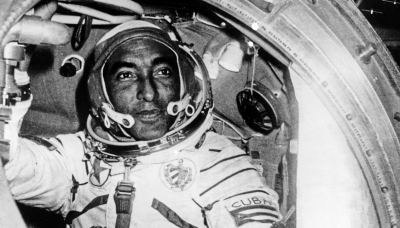Who is the first Latin American to fly into space?

Arnaldo Tamayo Méndez, (born Jan. 29, 1942, Guantánamo, Cuba), Cuban pilot and cosmonaut, the first Latin American, the first person of African descent, and the first Cuban to fly in space. After the revolution of 1959, Tamayo Méndez joined the Cuban air force as a pilot.
Born in 1942, Mendez makes no mention of his father in his book Un cubano en el cosmos (A Cuban in the cosmos). As he lost his mother to tuberculosis while just eight months old, he grew up as a poor orphan in Guantanamo.
Limited schooling
He worked as a shoeshine boy, sold vegetables, delivered milk and worked as an apprentice carpenter by the time he reached his teenage years. Even though he had limited opportunities for schooling, he excelled at it in whatever little chance he got.
After joining the Association of Young Rebels during the Cuban Revolution, Mendez made his way to a technical institute. Here, he saw a chance to pursue his dream of flying and he readily enrolled himself into a course for aviation technicians, passing it with flying colours in 1961.
His success at this course gave him the confidence to become a pilot and make his dream a reality. He was then selected to travel to the Soviet Union to further his studies and learn to fly the Soviet MiG – 15 fighter jet. Mandez rose through the ranks in the next 15 years, becoming a captain in the Cuban Air Force by 1978.
Interkosmos programme
During the time Mendez was making his way up the Cuban Air Force, the Soviet Union had designed and formed the Interkosmos space programme (1967) and had the first flight of this programme in 1978. The objective of Interkosmos was to help the Soviet Union's allies with crewed and unscrewed missions to space.
The search for the first Cuban Cosmonaut began in 1976 and a long list of 600 was shortlisted to two by 1978: Mendez and the other being Jose Lopez Falcon. It could have been purely based on merit, or it might have been an act of propaganda with political motivations, but what we do know is that Mendez was selected to fly aboard the Soyuz 38 mission.
On September 18, 1980, Mendez created history as he flew aboard Soyuz 38 along with Soviet cosmonaut Yuri Romanenko. On that same day, they docked at the Salyut 6 space station, and Mendez met Soviet cosmonauts Leonid Popov and Valery Ryumin as the hatch opened and was sealed.
Over the next seven days, Mendez completed 124 orbits around the Earth, conducting a number of experiments on science and health. There were a total of nine experiments, including those that studied stress, blood circulation, immunity, balance, and the growth of a single crystal of sucrose in weightlessness.
Instant fame
Mendez and Romanenko landed back on Earth on September 26 and the former was lauded by both the Cubans and the Soviets Mendez became an instant national hero and was honoured with the Hero of the Republic of Cuba medal, and received The Order of Lenin from the Soviets, among many other recognitions.
Mendez, who is now an 80-year-old, rose to the position of brigadier general following his space flight. He spent many years leading the education efforts of the Cuban army. Cuba's Museum of the Revolution in Havana is home to the space suit that Mendez used for his historic Voyage.
The Interkosmos programme successfully flew many non-Soviets, including India's Rakesh Sharma and astronauts from Britain, Japan, France, and Vietnam, among many other countries. Mendez's flight not only made him the first Cuban cosmonaut, but also the first with African heritage to make it to space.
Picture Credit : Google